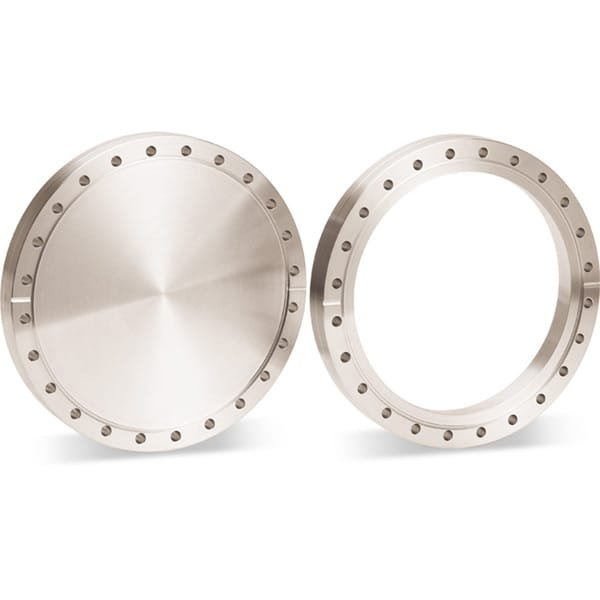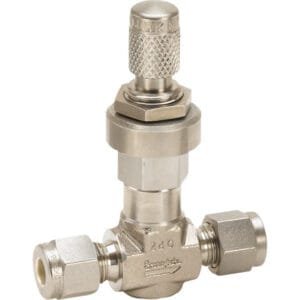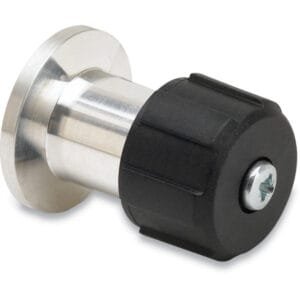DN100CF (6.00 OD) 316LN SS Standard ConFlat® (CF) UHV Flanges
Overview:
The DN100CF (6.00 OD) 316LN SS Standard ConFlat® (CF) UHV Flanges are high-performance flanges designed for ultra-high vacuum (UHV) applications. Manufactured from 316LN stainless steel, these flanges are engineered to provide exceptional strength, corrosion resistance, and reliable sealing under extreme vacuum conditions. Their precision design makes them ideal for use in industries that demand strict UHV standards, such as semiconductor manufacturing, research laboratories, and high-tech industries.
Product Features:
Material: Constructed from 316LN stainless steel, offering excellent corrosion resistance, high mechanical strength, and resistance to pitting and crevice corrosion in UHV environments.
Outer Diameter (OD): 6.00 inches
Flange Type: Standard ConFlat® (CF) flange, which ensures a secure, leak-tight seal, making it suitable for UHV and high-pressure applications.
Vacuum Rating: Designed for reliable performance in ultra-high vacuum systems, ensuring minimal outgassing and the maintenance of stable vacuum conditions.
Sealing Compatibility: Compatible with copper or metal seals to form an airtight, leak-proof connection.
Finish: Precision machined surfaces for smoothness and cleanliness, reducing the risk of contamination and enhancing long-term vacuum stability.
Configuration Options: Available in both rotatable and fixed configurations for flexible use in various vacuum system setups.
Applications:
Semiconductor Industry: Essential for UHV chambers used in semiconductor processing, including thin-film deposition, etching, and other processes where precise vacuum conditions are essential.
Scientific Research: Ideal for research applications requiring UHV conditions, such as materials science experiments, surface analysis, and particle physics research.
Aerospace and Space: Suitable for UHV systems used in space exploration and satellite technology, providing consistent performance in extreme conditions.
Vacuum Coating and Furnaces: Used in high-precision vacuum coating systems and vacuum furnaces where stable UHV conditions are crucial.
Industrial Vacuum Systems: Perfect for use in industries like optics, metallurgy, and electronics, where UHV systems are necessary for manufacturing and testing processes.
Advantages:
Durability and Strength: 316LN stainless steel construction offers exceptional durability, even in harsh vacuum conditions, ensuring long-term performance.
Leak-Proof Sealing: The ConFlat® design, combined with high-quality seals (copper or metal), ensures a tight, leak-free seal, critical for maintaining UHV conditions.
Precision Machining: The flanges are carefully machined to maintain flatness and smoothness, essential for high-performance vacuum sealing.
Flexibility: Available in both rotatable and fixed versions to accommodate different installation requirements.
Consistent Performance: Manufactured to maintain stable and reliable vacuum conditions over extended periods, ensuring minimal outgassing and optimal UHV system performance.
Manufacturing Process:
These DN100CF flanges are made through a cold-pressing and sintering process, followed by elastomer bonding to provide high-density, uniform structure and excellent durability. Each flange is cleaned thoroughly to meet stringent vacuum cleanliness standards and packaged carefully to protect them from environmental contaminants during shipping.
Ordering Table
| Flange Size/OD | Type | Flange Material | Part Number |
| Fixed | 316LN SS | 316LN SS | F0600N000NLN |
| Fixed Tapped | 316LN SS | 316LN SS | F0600N000NMLN |
| Rotatable | 316LN SS | 316LN SS | F0600N000RLN |
| Rotatable Tapped | 316LN SS | 316LN SS | F0600N000RMLN |
| Rotatable Tapped | 316LN SS | 316LN SS | F0600N000RTLN |
| Fixed Tapped | 316LN SS | 316LN SS | F0600N000TLN |
| Fixed | 316LN SS | 316LN SS | F0600N400NLN |
| Fixed Tapped | 316LN SS | 316LN SS | F0600N400NMLN |
| Rotatable | 316LN SS | 316LN SS | F0600N400RLN |
| Rotatable Tapped | 316LN SS | 316LN SS | F0600N400RMLN |
| Rotatable Tapped | 316LN SS | 316LN SS | F0600N400RTLN |
| Fixed Tapped | 316LN SS | 316LN SS | F0600N400TLN |





Reviews
There are no reviews yet.